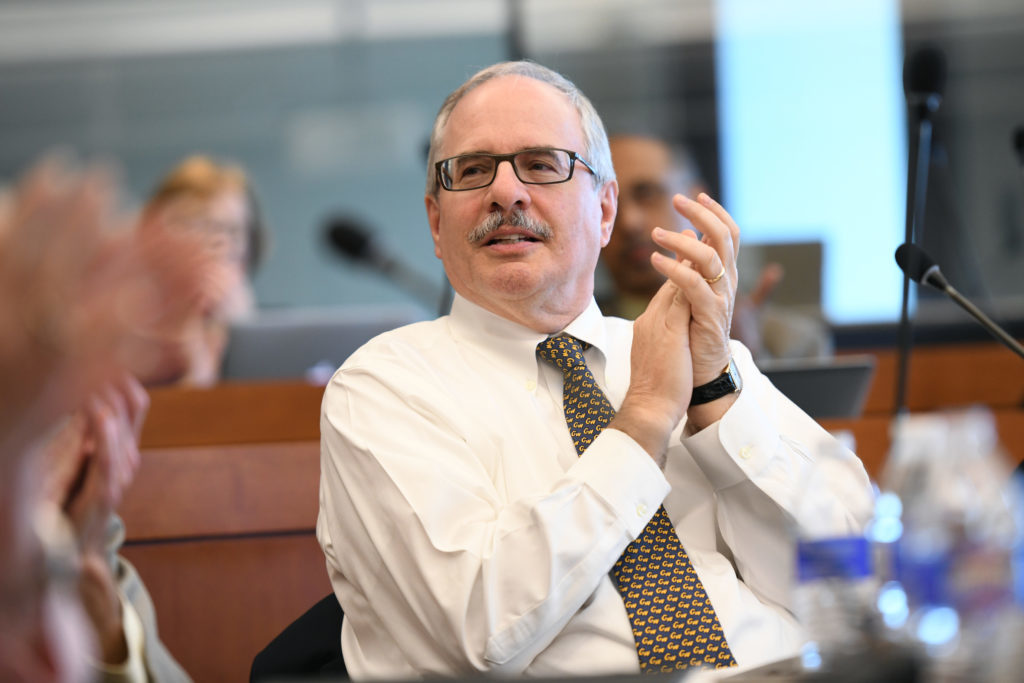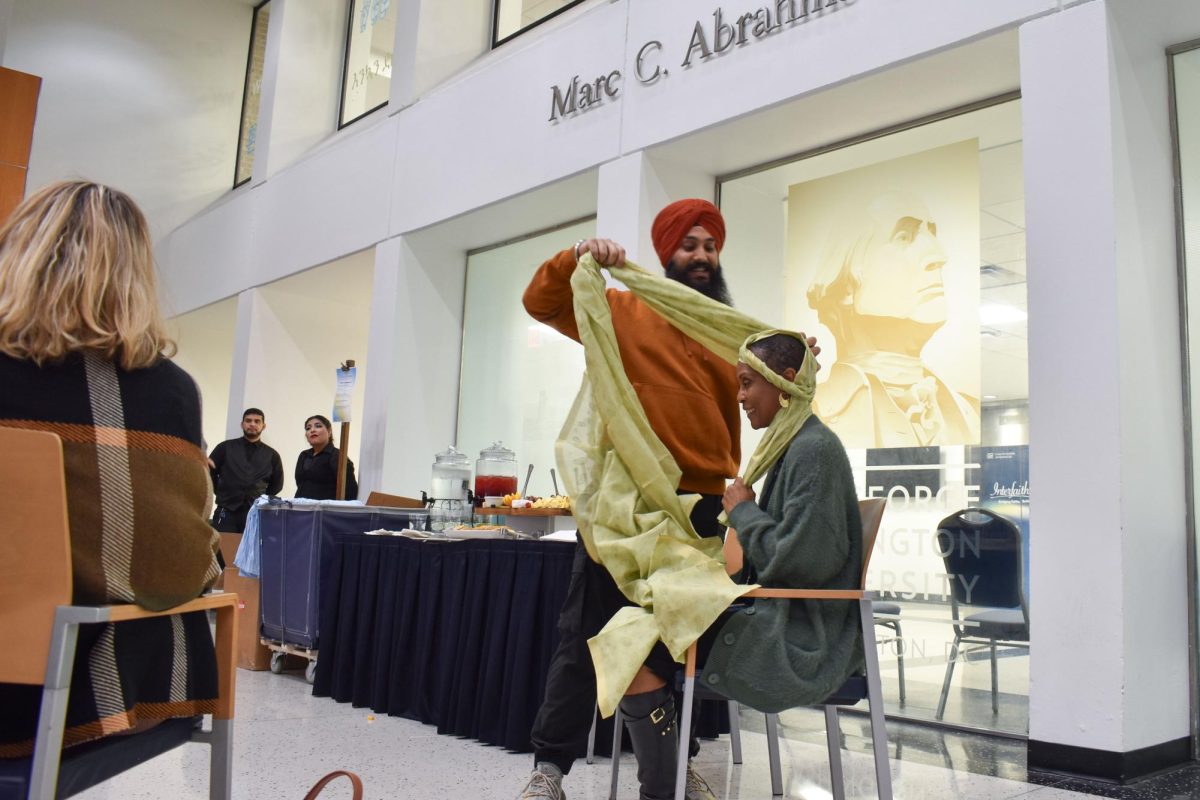Updated: May 14, 2018 at 1:08 p.m.
When University President Thomas LeBlanc stepped on campus last summer, he decided he would focus his tenure on improving staff and student morale and boosting GW’s standing as an international research institution.
His predecessor, Steven Knapp, had some similar goals – growing GW’s research profile was at the top of his agenda – but he also focused on expanding community service opportunities, increasing philanthropy and making the University more sustainable. Before Knapp, Stephen Joel Trachtenberg set out to bolster GW’s nationwide recognition, embark on on-campus development projects and multiply the University’s financial foundation.
Longstanding faculty and former administrators said that after nearly a year in office, LeBlanc’s background in computer science and his years as a top official at the University of Miami – one of GW’s peer institutions – set the stage for his first nine months on campus, distinguishing him from those that came before him.
LeBlanc didn’t encounter as steep of a learning curve during his first year as past presidents because of his time at Miami, faculty said, and his focus on student and staff satisfaction has made the GW community more trusting of his capabilities.
LeBlanc said he met with both Trachtenberg and Knapp – the only two living former University presidents – during his transition and after the start of his tenure last year.
“All university presidents must build on the legacy that came before them and also evaluate the needs of the university at the time of their leadership,” LeBlanc said in an email. “I believe this is what my predecessors did and this is how I am approaching the University’s priorities.”
LeBlanc has said from the beginning of the year he will focus his tenure on five key strategic initiatives, including the student experience, alumni engagement and GW’s medical enterprise. Students have said the institutional culture at GW is “transactional,” and GW’s alumni giving rate has been historically low.
Trachtenberg, who served as University president from 1988 to 2007, said LeBlanc is “liberated” to work on his own agenda because of the work previous presidents completed to set a base for the University. Trachtenberg worked on getting the University’s endowment – a financial bedrock that funds professorships, scholarships, construction projects and other University activities – to more than $1 billion.
“We started off with nothing,” he said. “President LeBlanc is able to build off the foundation of his predecessors.”
GW was a commuter school before former University President Lloyd Elliott, and Trachtenberg built five residence halls on campus over a 30-year period, including Shenkman Hall, The Dakota and Potomac House. He also acquired the Mount Vernon Campus in 1999.
Elliott, who led GW from 1965 to 1988, was known as a talented fundraiser after increasing the University’s endowment by more than $150 million in his years at GW. He also helped expand campus by building the Smith Center and Marvin Center and improved the University’s educational quality – notably cutting the University’s football program because he said the funds were needed for libraries and professors.
Trachtenberg said presidents’ different personality traits can impact whether faculty, staff and students feel heard, and being a more open communicator like LeBlanc is helpful in making the community feel heard. Knapp, he said, was “shier” and “more reflective,” which made it more difficult to connect with faculty.
“If when you walk down the street and you stop and talk to a University police officer or a maintenance person and say hello to them, if you run into a faculty member and ask them about their research, people like to be talked to and they like to feel that the president keeps track,” Trachtenberg said.
Knapp could not be reached for comment.
Anthony Yezer, a professor of economics who has been at GW since the Trachtenberg administration, said the largest gaps between the presidents’ leadership styles and priorities stem from their educational backgrounds. While LeBlanc was a computer science professor, other presidents have been trained in education leadership, the humanities and law.
While most don’t assume the role as president with all the necessary knowledge, he said computer scientists are more likely to understand the business model of a university because of their style of quantitative thinking.
“Very few people have ever even seen a modern business model of a large organization in action,” Yezer said.
LeBlanc entered the University at a time when financial stability may be on the horizon, which did not make faculty relations during the Knapp years easy, Yezer said. Under Knapp, 3 to 5 percent budget cuts were implemented across the University after an unexpected drop in enrollment in graduate schools in 2015.
Robert Chernak, the longstanding former senior vice provost and senior vice president for student and academic support services, who served in the role during both Trachtenberg’s and Knapp’s presidencies, said LeBlanc will be a “dramatic” shift in personality from Knapp. He said in talking with staff, he has heard that LeBlanc’s extroverted nature and enthusiasm has made morale “significantly better” in only one year.
“I think he has a global understanding of what needs to be done, not just in terms of learning but with the whole student experience,” he said.
Charles Garris, a professor of mechanical engineering who has been on the Faculty Senate since the Elliott administration, said LeBlanc is the first president to come to GW with experience at a school similar to GW.
While LeBlanc was the provost and executive vice president at one of GW’s peers, the University of Miami, from 2005 to 2017, he helped develop student entrepreneurship and balanced the school’s billion-dollar budget. The University of Miami, like GW, has its own hospital and a business school, and also has about 20,000 students.
Elliott came from leadership in K-12 education, and before he was the president of the University of Maine, he was a superintendent. His inexperience was part of the reason faculty first opposed his selection, Garris said. Trachtenberg had experience as the president of the University of Hartford, but the school was mostly an undergraduate institution and didn’t have a medical school, Garris said.
John Hopkins University, where Knapp served as provost and dean of the School of Arts and Sciences before coming to GW, was a university that GW strived to be more like, especially in terms of research, which is why Knapp was brought on to improve research at GW, Garris said.
“He comes to GW with really solid experience in the kind of university that GW is,” Garris said of LeBlanc.
This post was updated to reflect the following correction:
The Hatchet incorrectly reported that Robert Chernak was the former executive vice president and treasurer. He was the senior vice provost and senior vice president for student and academic support services. We regret this error.





